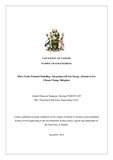Micro hydro potential modelling - integrating GIS into energy alternatives for climate change mitigation

View/
Date
2016-09Author
Chelelgo, Gerald CK
Type
ThesisLanguage
enMetadata
Show full item recordAbstract
This research focused on integrating GIS into energy alternatives for climate change mitigation by creating a GIS-based hydrologic model that can be used to identify sites that have significant potential for micro hydropower development within the River Perkerra catchment area. Hydropower is a clean and renewable energy source that remains largely untapped in the country and its development can be used to mitigate anthropogenic climate change by reducing reliance on fossil or bio-mass derived fuels. This research established the extent of this resource and whether the available sites with significant micro hydropower potential within the study area were amply copious to war-rant further development. Currently, such identification is done physically using means that are menial, costly and significantly time consuming. A 90-metre resolution Digital Terrain Model (DTM) data obtained from the Shuttle Radar Topography Mission and various GIS tools were used to create a hydrologic framework which was used to identify potential sites along River Perkerra that suit any desired head requirement for the purposes of locating micro hydropower plants. The derived model demonstrated that it is possible to identify sites at discrete geographic locations along any stream drainage network using GIS. In addition, the model also provides a decision support system that integrates a powerful graphical user interface, spatial database management system and a generalized river basin network flow model for the purposes of exploiting and developing micro hydropower. With sufficient data on catchment discharge and use of higher resolution DTM, the model can be further enhanced to accurately obtain the total micro hydropower potential of River Perkerra whereby the potential of every stream segment would be aggregated.
Publisher
University of Nairobi
